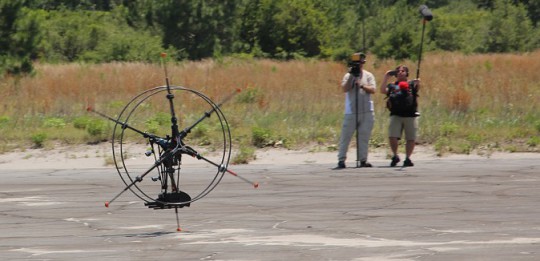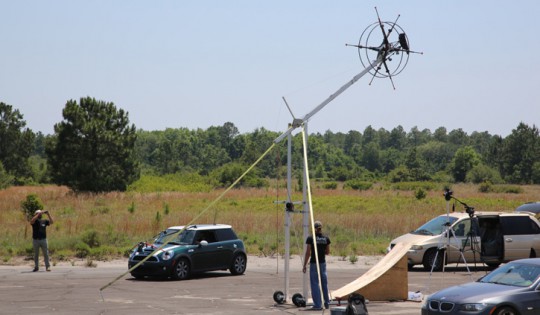Local Robot Sets Speed Record For Running Robots
June 2, 2014
A new land-speed record for legged robots was achieved recently by a robot that calls Escambia County home.
The Florida Institute for Human and Machine Cognition HexRunner robot reached an estimated 30-33 mph on an open course, without any support tethers.
The record-setting run was filmed by the Discovery Channel, which is expected to broadcast it later this summer.
“More significant than the top speed is showing that you can make a running robot that doesn’t need a lot of feedback from sensors, and you don’t need a lot of actuation,” said IHMC Senior Research Scientist Jerry Pratt, team leader of the HexRunner project.
HexRunner is a running robot with six spring-loaded legs revolving around a central hub, with three legs on each side of the hub. At the tip of the top leg it stands six feet high. Dr. Pratt said the speed was measured with a chase car and through analysis of high-speed motion video shot from the side.
“The speedometer on the chase car hit 33 while the robot was still running away from it,” he said. The 30 mph documented speed is a conservative figure based on motion analysis from video taken during the test. “We might be able to hit 45 mph with small modifications if we have a good run on a long enough course.”
The HexRunner is the “parent” of the OutRunner robot, a two-foot version based on technology licensed from IHMC to Robotics Unlimited, headed by Research Scientist Sebastien Cotton, who worked on the HexRunner team.
The ultimate goal, Dr. Pratt said, is to figure out how animals run in nature, an understanding that could produce breakthroughs in robotics.
“The high-level question is how can animals run with stability at high speeds?” he said. “And how can we make a robot to achieve the same feats?”
IHMC Research Scientist Chris Schmidt-Wetekam said one of the next goals of the FastRunner project is to develop a fully segmented leg that more closely mimics biology.
“We’re working toward more complicated robots,” Dr. Schmidt-Wetekam said. “Things look really promising in simulation, but it’s a lot more complicated in actuality, so we went back to basics. HexRunner checks off an important box on our checklist, and validates our simulation. OK, we can do this.”





Comments